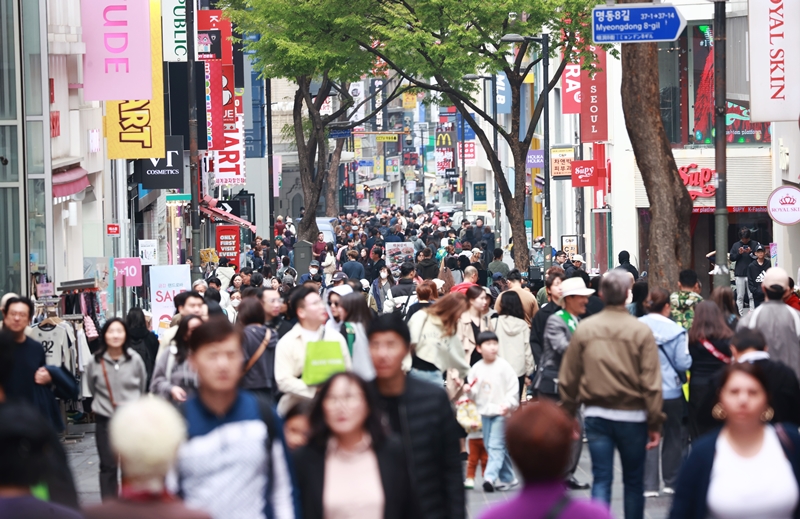
앞으로 20년 뒤면 한국에 사는 사람 100명 가운데 7명은 외국인이 될 거라는 관측이 나왔다. The number of foreign residents will rise to 7% of the national population in 20 years, a newly released report says.
통계청이 이 같은 내용이 담긴 ‘2022년 기준 장래인구추계를 반영한 내·외국인 인구추계 2022~2042년’을 11일 발표했다. Statistics Korea on April 11 made this prediction in its study of population projections for both Koreans and expats from 2022-42 using 2022 data.
연금·복지, 외국인, 다문화 교육·가족 등 정책대상별 인구추계 현황을 제공하기 위한 자료로, 장래인구추계의 불확실성을 감안해 출생과 사망, 국제이동 등의 가정을 조합한 3개 시나리오(중위·고위·저위)로 만들어졌다. 고위로 갈수록 높은 수준의 출산율과 기대수명, 국제순이동(입국자 수에서 출국자 수를 뺀 수치)의 조합이다.
The data was used to make population forecasts by policy target including pension and welfare, foreign residents, and multicultural education and families using three scenarios (medium, high and low) that combined assumptions on births, deaths and immigration to account for uncertainty in such projections. The high scenario assumed bigger levels of the birth rate, life expectancy and net international migration, or the number of arrivals minus that of departures.
발표 내용을 살펴보면 중위 시나리오 기준으로 한국의 총 인구는 2022년 5천167만 명에서 2042년에는 4천963만 명으로 감소한다. 인구 비율로 따지면 내국인은 96.8%(5천2만명)에서 94.3%(4천677만 명)로 줄어든다.
The medium scenario saw the national population decline from 51.67 million in 2022 to 49.63 million in 2042, with the percentage of Koreans dropping from 96.8% (52 million) to 94.3% (46.77 million).
반면 외국인은 165만 명에서 285만 명으로 증가할 것으로 보인다. 총인구에서 차지하는 비율이 3.2%에서 5.7%로 높아짐에 따라 2022년 대비 1.8배 높아질 전망이다. 특히 고위 시나리오 추정치에서는 외국인 인구는 361만명, 외국인 구성비는 6.9%까지 증가할 것으로 나타났다.
The number of foreign residents, however, was seen to rise from 1.65 million to 2.85 million over the 20-year period, up 80% from 2022 and boosting their share of the population from 3.2% to 5.7%. In the high scenario, the foreign population was seen to grow to 3.61 million or 6.9%.
15~64세 생산연령인구는 변화가 더 두드러진다. 중위 시나리오 기준 내국인 생산연령인구는 2022년 3527만 명에서 2042년 2573만 명으로 준다. 반대로 외국인 생산연령인구는 147만 명에서 236만 명으로 늘어날 것으로 예상됐다.
Change was more pronounced for the working-age population group of ages 15-64. The medium scenario forecast the number of such people to drop from 35.27 million in 2022 to 25.73 million in 2042 but that of the foreign working-age group to jump from 1.47 million to 2.36 million.
이주배경인구의 경우 2022년 220만 명에서 20년 후에는 404만 명으로 증가한다. 총인구 중 이주배경인구 구성비는 4.3%에서 8.1%로 늘어날 전망이다. 이주배경인구는 본인 또는 부모 중 한 명이 외국 국적인 사람, 또는 귀화한 내국인, 이민자 2세, 외국인의 합으로 산출한다.
For residents with an immigrant background, the number was seen to jump from 2.2 million in 2022 to 4.04 million in 2042, raising that demographic’s population share from 4.3% to 8.1%. A person in this group is defined as someone born abroad or with one immigrant parent, naturalized citizen, second-generation immigrant or foreign national.
이주배경인구 중에서도 귀화한 내국인은 2022년 22만 명에서 2042년 52만 명으로, 이민자 2세는 33만명에서 67만명으로 각각 2배 이상 증가할 전망이다. The number of naturalized citizens is expected to more than double from 220,000 in 2022 to 520,000 in 2042 and that of second-generation immigrants from 330,000 to 670,000.
이경미 기자 km137426@korea.kr
By Lee Kyoung Mi, km137426@korea.kr












